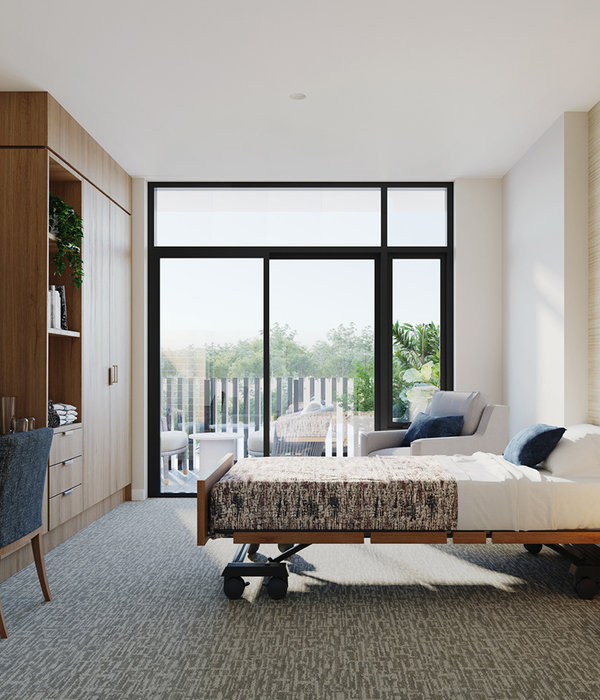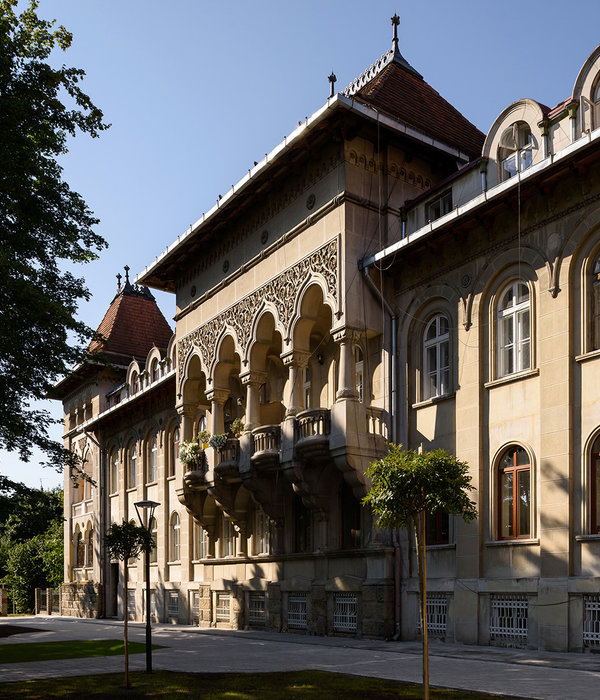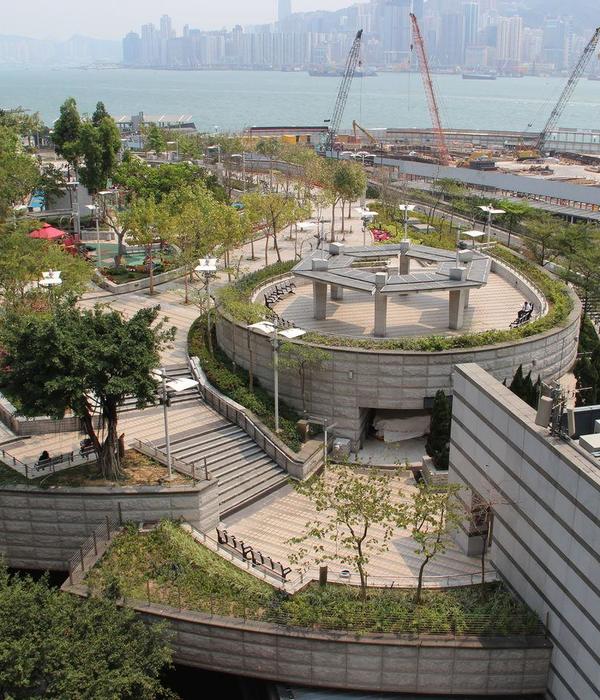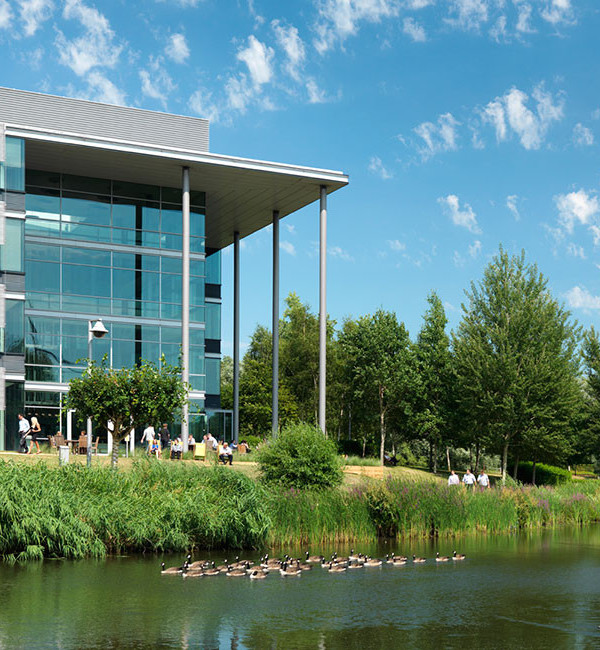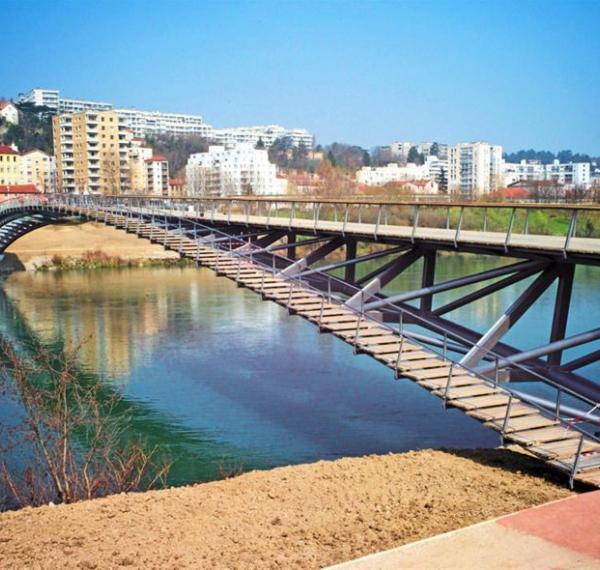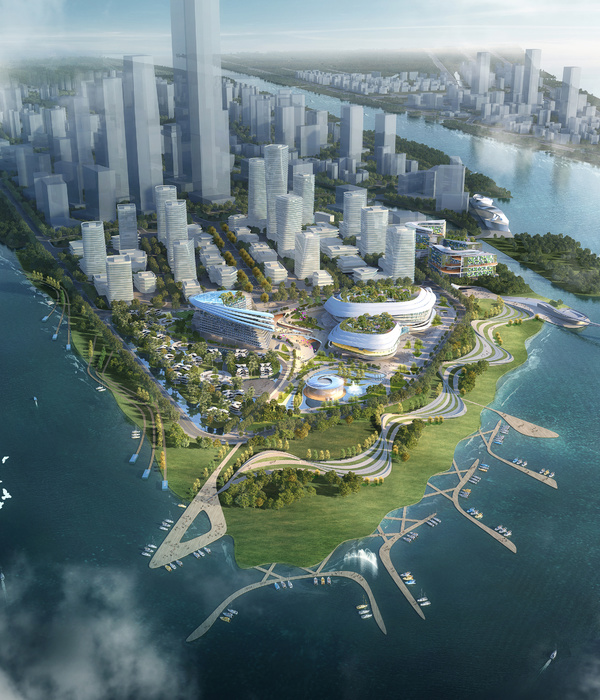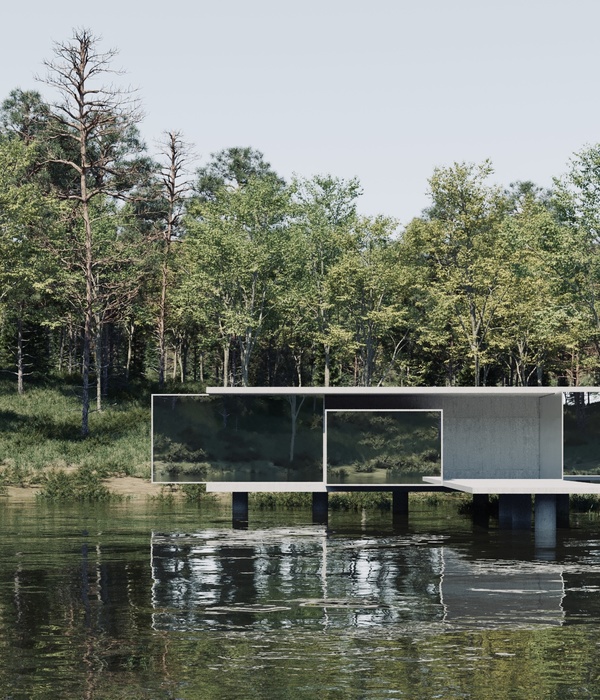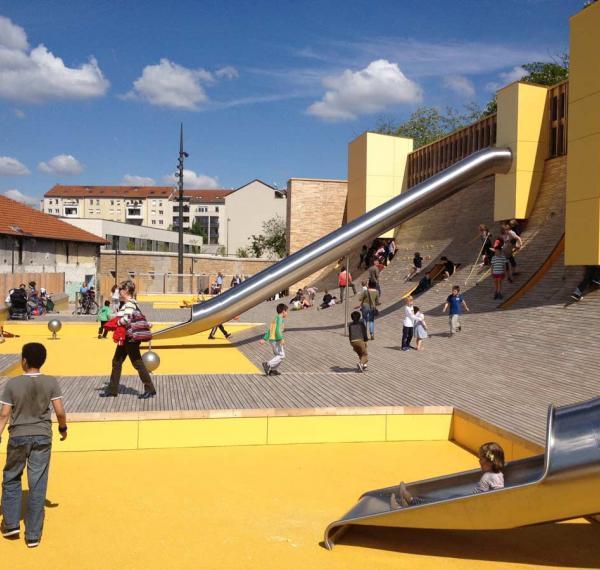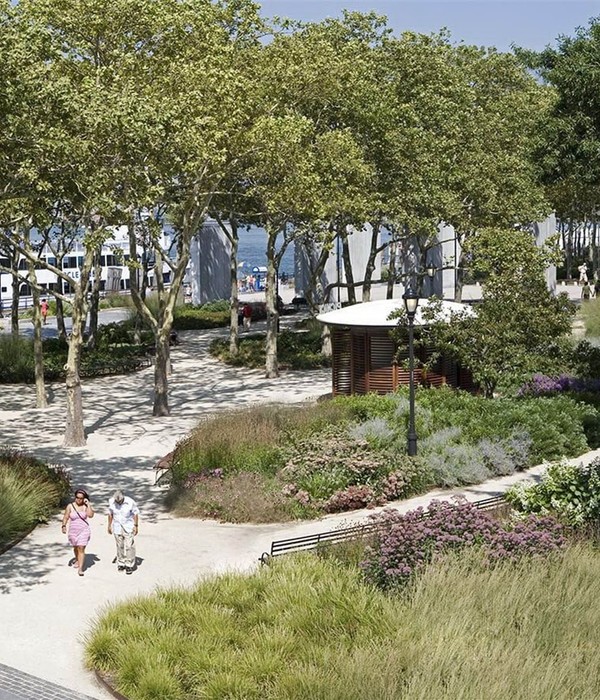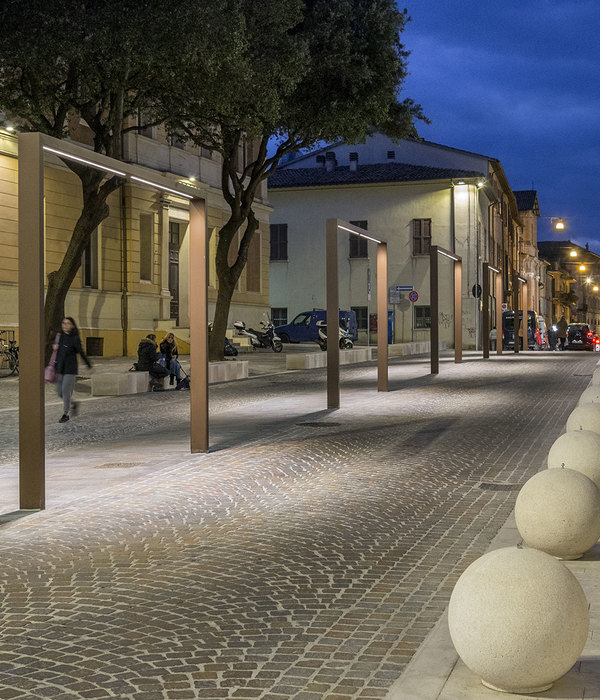“波特兰日本花园是拥有50多年历史的著名景观胜地。在经历了一次扩建之后,花园内的新旧元素被完美地融合在一起。景观设计师并未简单地选择保护的策略,而是将日本的传统技术与现代材料进行了结合。继承了家传技艺的石匠利用当地的花岗岩为花园打造出城堡般的墙壁。重新规划的入口和到达路径沿着蜿蜒的林间小路沿着坡地上升了90英尺的高度,最终抵达由隈研吾设计的一系列亭阁。这些亭阁的屋顶均种有绿植,并搭配以雨水滞留和再循环系统,保证了新花园能够一直延续到未来。” – 2020年评审委员会
“Within the Portland Japanese Garden—already a celebrated set of landscapes more than five decades old—an expansion blends together new and old seamlessly. Yet instead of simply adopting a preservation strategy, the landscape architects employed traditional Japanese techniques with contemporary materials; stonemasons with a long lineage produced the garden’s castle-like walls using local granite. A freshly choreographed entry and arrival sequence gently ascends 90 feet of grade along an accessible wooded switchback pathway to arrive at a sublime set of pavilions designed by Kengo Kuma; these feature planted rooftops alongside stormwater retention and recirculation systems that promise to sustain the new gardens well into the future.” – 2020 Awards Jury
文化交汇口是一个积极鼓励跨文化交流与实践学习的场所。虽然波特兰日本花园已经是一个足够著名的地标,且被认为是日本以外最正宗的日式庭园之一,此次的扩建工作仍然在很大程度上相异于传统日本花园的设计。文化交汇口创造了一种将生态原则、高性能可持续技术与现代日式设计美学相融合的环境,为广受社会认可的世界级教育项目提供了背景。文化交汇口通过其优雅而现代的空间恢复了曾经受到冲击的、地质复杂的景观,为日本文化和技艺的学习营造出一个沉浸式的互动环境。
The Cultural Crossing project is a place of inspired intercultural exchange and dynamic hands-on learning. While the project is an expansion of the existing Portland Japanese Garden, already a celebrated landmark known as one of the most authentic Japanese gardens outside of Japan, it diverges significantly from traditional Japanese garden design. Cultural Crossing creates a setting in which ecological principles and high-performance sustainable techniques blend with the aesthetics of modern Japanese design, and become the backdrop for a socially dynamic, world-class educational program. The elegant, contemporary spaces of the Cultural Crossing also restored the impacted, geologically complex landscapes of the site, and transformed the space into an immersive and interactive environment to learn about Japanese culture and craft.
▲文化交汇口项目涵盖了3.4公顷的新空间,包括一个新的入口亭阁、池塘和重新规划的、通往中央广场的入口路径。广场周围分布着三座新建筑,以及一系列花园空间、露台和步道。Cultural Crossing: Cultural Crossing includes 3.4 acres of new spaces, including a new entry pavilion, pond, and redeveloped entry path that ascends to a central plaza flanked by three new buildings, numerous garden spaces, terraces, and paths.
“文化交汇口”镶嵌在华盛顿公园内的一处绿树成荫的坡地上。该公园包含众多旅游景点,并且有着重要的历史意义。“文化交汇口”项目占地3.4英亩,包括一个新的入口亭阁、池塘以及重新规划的到达路径。其中,到达路径一路上生至中央广场,广场周围坐落着三座新建筑,提供了多样化的室内和室外空间,作为教学、集会和演讲的场所。场地跨越了90英尺高的垂直距离,令“文化交汇口”成为华盛顿公园森林顶端的、环境幽静的艺术和文化体验场所。具有视觉冲击力的景观设计被融入到针对复杂场地条件而提出的解决方案当中,同时结合了地质、雨水和可持续设计方面的功能。
在我们不断扩张的全球化世界里,“文化交汇口”以一种前所未有的方式重新定义了传统日式园林的作用:除了提供沉思式的花园体验之外,还扮演着一个强大的教育、阐释和多元文化的中心。为了实现这一大胆的提议,景观设计师将当代日本设计、西方的场地开发模式以及对环境高度敏感的基础设施建造方法进行了融合。在该项目中,花园本身对于保护日本园艺传统所起到的作用甚至超过了博物馆建筑,因其融合了现代的设计理念与环境敏感的开发方式,同时还为游客提供了学习日本艺术与文化的机会。项目还强调了无障碍设计,在改善游客体验的同时,展示了以公平方式实现文化交流的重要性。重新定义游客体验
改造的首要内容是建立明确的到达次序。在原来,游客需要穿越停车场、马路和服务庭院进入场地。在重新设计之后,客人们从旅程的一开始便能够收获到丰富的体验,并随着空间的序列逐步深入场地。在山脚下,新建立的Tanabe欢迎中心(Tanabe Welcome Center)提供了更加正式和吸引人的入口。游客们可以经由人行道穿越森林峡谷和跌落式的雨水花园,最终到达顶部的文化村(Cultural Village)。
文化村由三座新建筑和中央的Tateuchi庭院广场构成。这三座建筑分别是漂浮在峡谷之上的Umami茶馆、容纳了Tanabe画廊、多功能教室、花园礼品店及Vollum图书馆的村屋(Village House),以及容纳了手工坊、工作室和管理人寓所的花园屋(Garden House)。庭院的外缘随处可见传统日本庭园的设计元素,包括盆栽露台、Tsuboniwa花园和石砌围墙等,使开放空间成为设计中的亮点。一系列全新的空间为各种课程、培训和活动的举办创造了条件。此外,文化村还增设了包括讲座、研讨会和园艺课程在内的一系列教学计划。建筑物的设计充分尊重了景观,试图与自然环境充分交融。室内外空间的紧密连接为游客带来通透而流畅的沉浸式体验,同时能够很好地适应各类文化活动和课程对场所的不同要求。
虽然空间的设计都具有明显的现代特征,项目团队还是尽可能地结合了传统的施工和安装方法,以强调古代记忆与现代设计背景的持续关联。景观设计师、设计团队成员和承包商所面临的共同挑战是,如何将传统的方法恰当地转化为适合建造的前沿项目。为了维持庭园区域内既有的日本传统特征,“文化交汇口”选择了产自本地的材料和植物,其中石头等材料均是从当地资源中经由人工挑选。位于广场西缘的中世纪城堡围墙是结合传统与现代方法的一个值得注意的例子:它是由一位日本传统石匠(第15代传人)使用当地出土的东俄勒冈贝克蓝色花岗岩砌筑而成。
环境管理是该项目的一个统一主题,而场地本身在环境和地质上的复杂程度也让文化交汇点成为了创新设计及场地开发方式的典范。由绿色屋顶、雨水收集和本土花园构成的系统将各个空间连接在一起,最大程度地降低了地质风险、提高了水质,同时让游客们意识到自身在保护自然环境方面所肩负的责任和作用。
一部分平台、花园和建筑物被建造在曾经发生过滑坡的地点,其布局旨在尽可能地减少地层移动带来的影响,并防止滑坡速度的增加。团队开发了一个全面的雨水收集系统,以限制可能加速滑坡的雨水渗透,同时利用收集到的水创造了一个额外的雨水花园展示区,作为贯穿场地的季节性特色景观。
文化交汇口被华盛顿公园广阔的自然环境所包围,在一个多世纪的人类介入过程中,公园的环境受到了开发和物种侵入带来的严重影响。在开发之前,茂密的森林为西山的陡坡提供了稳固的支撑;在经过砍伐和开发后,项目所在场地已经被化为城市的环境保护区之一。设计团队将开发重点放在了曾经受到干扰的区域,包括原先的维护及运营设施所在的位置。景观设计师清除了场地中的入侵物种,栽种了新的植物以恢复森林生态,同时保留了场地中较为重要的树木。严谨的背景勘察工作和对环境敏感原则的重视最终让一系列空间得以与太平洋西北道格拉斯冷杉林无缝地相融。
设计团队还寻找机会探索和测试新型环保可持续技术和材料。村屋和花园屋安装的绿色屋顶系统在美国还属首例。该系统是与一家日本公司合作开发,采用了由织物染色设施废料制成的铺砖。这种铺砖具有优秀的透水性和保水性,可以为种满景天属植物的屋顶提供理想的基底,同时保持与整体项目相适应的超薄外观。绿色屋顶同时也从视觉上直观地展现了项目中大范围使用的雨水处理系统。雨水输送和处理的过程被开放地呈现在整个扩建区域当中,以一种具有惊人美感的方式减少了水污染带来的负面影响,同时还能最大程度地降低滑坡区域的水分渗入。
文化交汇口的多文化、跨学科设计及活动的举办和运营团队本身就具备了国际性和跨学科的特征。景观设计团队由庭园主管和景观设计公司组成,合作者包括当地的建筑师以及日本建筑师团队、庭园工作人员以及公共机构相关人员等。来自波特兰和东京的成员共同参与了项目。在整个设计过程中,当地景观设计公司与庭园主管建立了稳固的合作关系,使传统的设计和技术能够充分适应于当地的设计规范以及最优的可持续实践方法。
将传统日本庭园改造为文化互动与实践型学习的场所,无疑需要具备前瞻性的眼光;同时,高度敏感的场地也需要一个在环境层面上足够先进的解决方案。对于波特兰日本花园而言,文化交汇口项目有效地增加了机构的访问量,并再次证明了其作为国际公认的文化中心所保有的领先地位及荣誉。对于设计师而言,文化交汇口项目提供了一个以设计为导向、以场所为基础的将日本设计融入当代环境的范例。综合性的水处理和岩土工程设计使设施足以维持一整代人的使用,展现了环境创新在一个气候和社会都发生着重大变化的时代所发挥的作用。
▲场地平面图:在经过重新设计之后,游客们从旅程的一开始便能够收获到丰富的体验,并随着空间的序列逐步深入场地。Site Plan: The design transformation creates a rich continuous visitor experience from the initial arrival, consistently articulated through every element of the sequence.
▲到达路径:“文化交汇口”镶嵌在波特兰西山华盛顿公园内的一处绿树成荫的坡地上。Arrival Sequence: Cultural Crossing is nestled into forested slopes of historic Washington Park in Portland’s west hills.
▲解决地质条件带来的挑战:一部分平台、花园和建筑物被建造在曾经发生过滑坡的地点。混凝土板上铺设了一层沙子,并留出了足够宽的伸缩缝隙,使铺装可以随着地面而弯曲。Working with Geological Challenges: Partially located on a historic landslide, the terraces, gardens, and buildings are organized to work with the slide. Pavers are sand set on a concrete slab with large expansion joints, so that paving can flex as the ground shifts.
▲综合雨水处理系统:完整而美观的雨水管理系统旨在限制可能加速滑坡的雨水渗透,游客在森林中攀升的过程中将穿越不同类型的雨水花园和景观。Integrated Stormwater System: The complete system of beautiful stormwater management elements designed to limit infiltration that may hasten the slide, accompanies visitors as they ascend through the forest, traversing the varied stormwater gardens and features.
▲Tanabe游客中心:游客们会首先进入游客中心处的雨水花园。Tanabe Welcome Center: Visitors are first introduced to the stormwater treatment gardens at the Tanabe Welcome Center.
▲Tanabe雨水花园:在深入路径的过程中,游客会遇见一系列相互联系的可持续设计元素,包括雨水处理景观、种植着本地植物的花园和绿色屋顶等。它们将不同空间连接在一起,同时提醒着他们对于环境的责任。Tanada Stormwater Garden: When visitors ascend the path, they encounter a combination of linked approaches to sustainable design including stormwater features, native gardens, and green roofs that tie the spaces together and remind visitors of our responsibility to our environment.
▲以景观为重点: 建筑物的设计充分尊重了花园环境,与周围的自然景观融为一体。Landscape is the Focus: The architectural design of the buildings is deferential to the garden – blending into the natural surroundings.
▲测试绿色屋顶材料:屋顶花园采用了由织物染色设施废料制成的铺砖,在美国还属首例。Testing a Green Roofing Material: Tiles made from the waste of fabric dyeing facilities developed by a Japanese company was used here as a green roof for the first time in the United States.
▲文化村:文化村由三座新建筑和中央的Tateuchi庭院广场组成。Cultural Village: The Cultural Village is formed by three new buildings arranged around the Tateuchi Courtyard plaza.
▲技艺:虽然空间的设计都具有明显的现代特征,项目团队还是尽可能地结合了传统的施工和安装方法,以强调古代记忆与现代设计背景的持续关联。Craftsmanship: While the design of the spaces is distinctly contemporary, wherever possible, traditional execution methods were integrated, demonstrating the continued relevance of ancient techniques in a modern design context.
▲城堡围墙:位于广场西缘的中世纪城堡围墙是由一位日本传统石匠(第15代传人)使用当地出土的东俄勒冈贝克蓝色花岗岩砌筑而成。Castle Wall: The authentic medieval castle wall located on the west edge of the plaza was built by a 15th-generation Japanese stonemason using Eastern Oregon Baker Blue granite.
▲国际公认的文化中心:对于波特兰日本花园而言,文化交汇口项目有效地增加了机构的访问量,并再次证明了其作为国际公认的文化中心所保有的领先地位及荣誉。An Internationally-Recognized Cultural Center: For the Portland Japanese Garden, Cultural Crossing increased visitation and reaffirmed the institution’s leadership and distinction as an internationally-recognized cultural center.
▲国际文化交流场所:文化交汇口项目将波特兰的日本庭园变成了一个文化交流的场所。A Place of Intercultural Exchange: Cultural Crossing transforms Portland Japanese Garden into a place of cultural dialogue.
▲教学计划:新的空间将提供一系列新的讲座、研讨会和园艺课程。Educational Offerings: The new space allowed for an increase in educational offerings including lectures, workshops, and a new professional course.
▲传统与现代的融合:文化交汇口项目提供了一个以设计为导向、以场所为基础的将日本设计融入当代环境的范例。Blending Traditional and Contemporary: Cultural Crossing provides a design-forward, place-based model for contextualizing Japanese design in a contemporary setting.
Cultural Crossing is nestled into forested slopes of Washington Park, a significant historic public park that contains a variety of major visitor venues, in Portland’s west hills. The 3.4 acre development includes a new entry pavilion, pond, and redeveloped entry path that ascends to a central plaza flanked by three new buildings, numerous garden spaces, terraces, and paths. These new spaces, both indoor and outdoor, are programmed for education, gatherings, and interpretation. The site traverses 90 feet of grade, making Cultural Crossing an elevated, secluded setting for arts and cultural experiences perched within Washington Park’s forest. The visually striking landscape design is embedded with solutions to the site’s complex environmental conditions—incorporating geotechnical, stormwater, and sustainable design functions.
In our increasingly expanding, global world, Cultural Crossing re-envisions the role of the traditional Japanese garden in a manner not found at any other: it serves as a strong educational, interpretive, and multicultural hub alongside traditional, contemplative garden experiences. To fulfill this bold initiative, the Landscape Architects combined contemporary Japanese design, Western site development methodologies, and a highly context-sensitive approach to sustainable infrastructure and resiliency. By approaching the garden as something greater than a museum that preserves Japanese gardening traditions, the project blends together modern design ideals, environmentally sensitive development, and opportunities for visitors to learn the arts and culture of Japan. Accessibility was also addressed, improving the experience for all visitors and demonstrating the importance of an equitable approach to cultural exchange.
The renovation begins by clarifying the arrival sequence. Previously, visitors approached the site by passing through parking lots, roadways, and service yards. The transformation creates a rich continuous visitor experience from the initial arrival that is consistently articulated through every element of the sequence. The Tanabe Welcome Center, a more formal and inviting new entry, welcomes visitors at the base of the hill. A pedestrian path ascends through the forested ravine, traversing cascading stormwater gardens, culminating in the Cultural Village above.
The Cultural Village is formed by three new buildings arranged around the Tateuchi Courtyard plaza: the Umami Café, a tea shop that hovers above the ravine; the Village House, that contains the Tanabe Gallery, a multi-purpose classroom, the Garden Gift Shop, and the Vollum Library; and the Garden House, where the garden’s workshop, studio, and curator’s suite are located, as well as additional horticultural education and exhibition areas. Contemporary approaches to traditional Japanese garden elements, including a Bonsai terrace, Tsuboniwa garden, and castle wall enrich the Tateuchi Courtyard’s edges, making the open space a focal point of the design. This new series of spaces creates opportunities to host more classes, training, and events. The Village also increases the number of educational offerings including lectures, workshops, and a new professional gardener education program. The architectural design of the buildings is deferential to the landscape, attempting to blend the structures into the natural surroundings. Strong indoor-outdoor relationships create a feeling of permeability and interconnectedness immersing visitors in the garden context, with spaces that are adaptable for indoor-outdoor cultural events and classes.
While the design of the spaces is distinctly contemporary, traditional methods of execution were integrated wherever possible to demonstrate the sustained relevance of ancient techniques in a modern design context. A central challenge for the Landscape Architects, design team members, and contractors was to appropriately translate traditional methodologies into a buildable, cutting edge project. In keeping with Japanese tradition in the existing garden areas, Cultural Crossing utilizes local and regional materials and plants; stone and other materials were hand-selected from local sources. A notable example of the team’s twist on an historic/modern approach is the authentic medieval castle wall located on the west edge of the plaza, which was built by a 15th-generation Japanese stonemason using locally sourced Eastern Oregon Baker Blue granite.
Environmental stewardship is a unifying theme of the project, and the site’s environmental and geological complexity make Cultural Crossing a paradigm for innovative design and site development approaches. A combination of systems including green roofs, stormwater features, and native gardens tie the spaces together, minimize geotechnical risks, enhance water quality, and remind visitors of our role and responsibility in our natural environment.
Partially located on a historic landslide, the arrangement of the terraces, gardens and buildings is organized to minimize the impacts of earth movement and to safeguard against hastening the slide. A comprehensive and innovative stormwater collection system was developed to collect water, limit infiltration that might hasten the slide, and use the resulting water to create an exceptional display of stormwater gardens as seasonal features throughout the site.
Washington Park, the large, mostly natural park which surrounds the Cultural Crossing site on all sides, has been highly impacted by development and invasive species over more than a century of human use. Prior to development, this rich forest stabilized the steep slopes of the west hills; the project site was subsequently impacted by logging and buildings, but is now designated as one of the city’s environmental conservation zones, the design team focused development in areas of previous disturbance, including the location of the former maintenance and operations facilities. The Landscape Architects’ design removed invasive species, replanted areas to restore the forest ecology, and preserved significant trees. The rigorous background work and focus on environmentally-sensitive principles resulted in spaces that are seamlessly nestled within the surrounding Pacific Northwestern Douglas Fir forest.
The design team also looked for opportunities to explore and test new environmentally sustainable techniques and materials. Notably, the green roof system installed on the Village House and Garden House is the first of its kind in the United States. The system was developed in collaboration with a company in Japan that developed a tile made from the waste left by fabric dying facilities. The ceramic tile has excellent water permeability and retention to provide a foundation for a sedum green roof, while maintaining an ultra-thin profile that fits within the overall project design. The green roof is also one of the visual acknowledgements of the project’s extensive stormwater treatment system. The conveyance and treatment of stormwater is openly expressed throughout the entire expansion area in a way that is strikingly beautiful, while lessening the negative impacts of water pollution and simultaneously, minimizing water infiltration in the area of the landslide.
The multicultural, interdisciplinary design and activities of the Cultural Crossing were delivered by a team that was itself international and interdisciplinary. The Landscape Architects, consisting of the Garden Curator and a landscape architecture firm, collaborated with a team of local and Japanese architects; Garden staff; and public agency stakeholders. The collaboration included team members in both Portland and Tokyo. Throughout the design process, the local landscape architecture firm and the Garden Curator worked together to adapt traditional designs and techniques to local requirements and sustainable best practices.
Transforming a traditional Japanese garden into a venue for cultural interaction and hands-on learning demanded a high level of vision; the highly sensitive site required an environmentally progressive approach. For the Portland Japanese Garden, Cultural Crossing increased visitation and reaffirmed the institution’s leadership and distinction as an internationally-recognized cultural center. For designers, the Cultural Crossing provides a design-forward, place-based model for contextualizing Japanese design in a contemporary setting. The integrated water and geotechnical design, which will sustain the facility for a generation, underscores the role that environmental innovation plays in times of significant climate and social change.
{{item.text_origin}}

